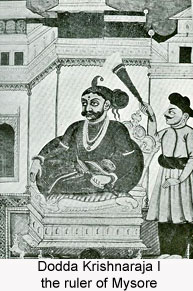 Dodda Krishnaraja I was the ruler of Wodeyar dynasty of Mysore. At that time it was a petty kingdom in southern India. The reign of Dodda Krishnaraja I lasted from 1714 to 1732.
Dodda Krishnaraja I was the ruler of Wodeyar dynasty of Mysore. At that time it was a petty kingdom in southern India. The reign of Dodda Krishnaraja I lasted from 1714 to 1732.
Early Life of Dodda Krishnaraja I
Dodda Krishnaraja I was born on 18 March 1702. Dodda Krishnaraja I was the first-born son of Kanthirava Narasaraja II, by his second wife Chelvaja Ammani Avaru. A month before his tenth birthday upon his father`s death, he acceded to the throne of Mysore. Although Dodda Krishnaraja I was married nine times, direct descent in the Wodeyar lineage stopped with him; a son was born to his first wife, but died aged six months.
Rule of Dodda Krishnaraja I
Dodda Krishnaraja I accessed the throne of Mysore in the year 1714. Just before Dodda Krishnaraja`s accession, a political change had come in the governance of the Mughal Province of Carnatic Bijapur to the north and northeast of Mysore. In the year 1713, Carnatic-Bijapur was split into a Payanchyat jurisdiction with capital at Arcot. It was governed by a newly styled Nawab of Arcot, and a Balaghat jurisdiction, governed by a newly-styled Nawab of Sira. In the same year, Sadat-ulla Khan was made the new Nawab of Arcot, and Amin Khan was appointed Nawab of Sira. Mysore, however, remained a formal tributary state of Sira. This village division, and the resulting loss of revenue from the rich maidan region of Mysore, made Sadat-ulla Khan unhappy and, in collusion with the rulers of Kadapa, Kurnool, and Savanur and the Maratha Raja of Gutti, he decided to march against Dodda Krishnaraja I. However, the Nawab of Sira was anxious to make the coalition`s action, hit upon a plan himself of reaching the Mysore capital, Seringapatna. Finally, both of the Nawabs settled upon a joint invasion led by the Sadatullah Khan. Dodda Krishnaraja, for his part, was able to buy off this formidable confederacy by offering a tribute of about one crore.
Death of Dodda Krishnaraja I
Dodda Krishnaraja died on 5 March 1732 at the age of 29. Later he was succeeded by an adopted son.



















